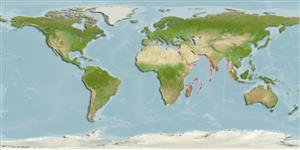Environment: milieu / climate zone / depth range / distribution range
Ecología
marino; salobre asociado a arrecife; rango de profundidad 1 - 50 m (Ref. 28016), usually 1 - 12 m (Ref. 90102). Tropical; 30°N - 6°S, 19°E - 112°E
Indiant Ocean: from East Africa, Seychelles, Comoro Islands, Madagascar, Reunion, Mauritius and Rodriquez Island; East Andaman Sea off Thailand and Myanmar; Bali, Indonesia.
Tamaño / Peso / Age
Maturity: Lm ? range ? - ? cm
Max length : 45.0 cm SL macho / no sexado; (Ref. 1419); common length : 30.0 cm TL macho / no sexado; (Ref. 2871); edad máxima reportada: 2.50 años (Ref. 42001)
Short description
Claves de identificación | Morfología | Morfometría
Espinas dorsales (total) : 13 - 14; Radios blandos dorsales (total) : 10; Espinas anales: 7; Radios blandos anales: 9 - 10; Vértebra: 23. Coloration highly variable; influenced by substrate's color and mood of the fish. Upper greenish to sandy brown, paler below. Color patterns extend to the fins. Spines slender, pungent and venomous. Preopercular angle 88°-98°; cheeks with few scales; midline of thorax without scales between pelvic ridges. Long flap of anterior nostril shortens with increasing age.
Inhabits inshore areas and inner reefs (Ref. 9710). Often occurs among seagrasses to browse on 'aufwuchs'. Forms schools. A food fish that is occasionally poisonous (Ref. 4537).
Life cycle and mating behavior
Maturities | Reproducción | Spawnings | Egg(s) | Fecundities | Larva
Woodland, D.J., 1990. Revision of the fish family Siganidae with descriptions of two new species and comments on distribution and biology. Indo-Pac. Fish. (19):136 p. (Ref. 1419)
IUCN Red List Status (Ref. 130435)
Human uses
Pesquerías: comercial
Herramientas
Special reports
Download XML
Fuentes de Internet
Estimates based on models
Preferred temperature (Ref.
123201): 24.6 - 28.9, mean 27.5 °C (based on 745 cells).
Phylogenetic diversity index (Ref.
82804): PD
50 = 0.5000 [Uniqueness, from 0.5 = low to 2.0 = high].
Bayesian length-weight: a=0.01738 (0.01030 - 0.02933), b=2.95 (2.81 - 3.09), in cm total length, based on LWR estimates for this species & Genus-body shape (Ref.
93245).
Nivel trófico (Ref.
69278): 2.3 ±0.2 se; based on diet studies.
Resiliencia (Ref.
120179): Alto, población duplicada en un tiempo mínimo inferior a 15 meses (tmax=2.5).
Fishing Vulnerability (Ref.
59153): Low to moderate vulnerability (26 of 100).
Nutrients (Ref.
124155): Calcium = 32 [16, 70] mg/100g; Iron = 0.634 [0.315, 1.310] mg/100g; Protein = 19.3 [18.1, 20.5] %; Omega3 = 0.149 [0.085, 0.263] g/100g; Selenium = 23.1 [10.2, 49.1] μg/100g; VitaminA = 39 [12, 120] μg/100g; Zinc = 1.57 [0.64, 3.06] mg/100g (wet weight); based on
nutrient studies.
